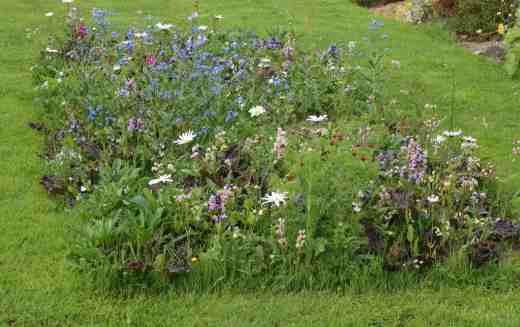Keeping more bees happy
I posted yesterday about a bed filled with annuals to keep pollinators happy. Today I am posting about another bed, this time with a mix of flowers, many of them perennial, that is supposed to encourage pollinators too.

I apologise for the photo but the planting was included in a ‘jobs for the week’ for my Garden News work and I have to appear in that. But it shows that I sprayed off the grass and grew all the plants in cell trays and they were planted in early April. It looked a right mess. I used a bulb planter for ease and speed since there were hundreds of plants. I put them in far too close but I will let things take their course and some things will thrive and others will die. Even in the wild, not all native plants will grow in every area so these conditions will suit some plants better than others. My mix was rather random and has no great merit. It includes seed-raised leucanthemum (a dwarf, large-flowered kind to represent ox-eye daisies) and nepeta ‘Grand View’ to provide contrasting tubular flowers. Despite the fact that the ‘lawn’ is full of plantain, I planted lots of plantains but the ‘ornamental’ form called ‘Purple Peversion’ with purple, crisped and curled leaves. It should be just as attractive to wildlife and plantain seeds are eaten by birds which I hope they are because if it seeds into the surrounding lawn it will look awful!

I also put in a few perennial violas as well as lots of Silene vulgaris to please the moths.

There are a few annuals too, including some cynoglossum mentioned yesterday. I popped in a few antirrhinums just to see what would happen but the major annual, for no particular reason, is Adonis aestivum, a widespread annual from the Mediterranean basin. This is sometimes called pheasant’s eye because of the small, blood red flowers.

It is a hardy annual that is poisonous and allegedly produces chemicals from the roots that slow the growth of surrounding plants. It doesn’t sound like a good thing to grow among the other plants but I can’t see any effect so far. It is often recommended as a good plant to provide a bold splash of red in the garden but only by people who have never grown it – the flowers are only 1cm across – although there are forms with orange or even yellow flowers. It is a nice thing but only really for, what the old Herbalists used to say, ‘the gardens of the curious’.

The idea is that I will shear off the bed in autumn, allowing seeds of all plants to scatter, and then basically leave it. Grass is already moving back in as is clover. I am removing all willowherbs as I see them, but I will not do too much weeding. I will add more to the bed as I get them. I am not sticking to purely native plants, as you can see, but the aim is to provide flowers of a wide range of shapes and sizes for as long as possible and plenty of cover for beneficial insects as well as slugs and snails.
Well done for good work! 🌍😊
Thank you
You are welcome 🌍😊
Let me test your brain: Can you suggest annuals as a cover-over for large plantings of snowdrops in parts of the garden which are dry? Smaller plants, low-growing would be best.
that is a really tricky one because it will be shady too and a dry, shady spot is going to be a problem for annuals. In addition, you dont really want lots of foliage from autumn-germinating annuals. So that restricts it to annuals that have fine foliage so they don’t swamp the snowdrops in spring. Nigella seems the obvious choice but not perfect. Nemophila might work too but I think the best would be impatiens balsamina. I know you have a quite logical suspicion of impatiens but this one seeds gently in my garden. It does not germinate till quite late in spring so would not bother the galanthus. The seedlings are easy to pull up and it would definitely grow in some shade. It is not, in my experience, as aggressive as most annual impatiens so I doubt it would become a nuisance.
Good suggestions for me to think about there. Welsh poppies have proven reasonably successful in one bed.
That is a good option but I was very conscious that you may want the ground clear for the snowdrops, hence my limited offerings!